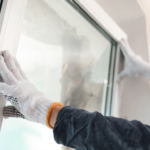Windows and doors do far more than bring light and access to your home, they play a major role in how well it retains heat. Their performance is measured by one key metric: the U-Value. A U-Value shows the rate of heat transfer through a material, measured per square metre for every degree of temperature…
Category Archives: Air Tightness Testing
Air Leak Detection: How To Detect Air Leaks
Air leaks are one of the most common and costly causes of energy loss in homes and commercial buildings. Whether you’re looking after you’re home, managing a rental property, overseeing a commercial office, or improving a new build, detecting leaks early is essential to safeguard energy efficiency, reduce maintenance costs, and optimise overall performance. Air…
Does My Property Need Trickle Vents?
Ventilation ensures occupant health and structural durability. As buildings become more energy-efficient and airtight, the need for effective ventilation systems, like trickle vents (trickle ventilators), increases. Homeowners, builders, property managers, and anyone involved in constructing, renovating, or maintaining buildings should understand how to use them. This guide offers insights into trickle vents, their purpose, how…
Air Pressure Test: New Build Air Testing Explained
Air leakage can cause a significant amount of a building’s energy loss, highlighting the critical role that airtightness plays in the energy efficiency of new buildings. Ensuring a well-sealed building improves its energy performance, enhances occupant comfort, and reduces environmental impact. This guide will explore and explain the process of new-build air testing, a crucial…
Air Tightness Testing: Pulse Test Vs Blower Door Test
Air tightness testing is an essential step in ensuring energy efficiency and environmental control within buildings. This process not only helps to identify leaks and drafts that can lead to higher energy costs but also plays a crucial role in maintaining the durability and comfort of a structure. While there are several methods to measure…
Building Regulation Compliance 2023: The Ultimate Guide
Are you embarking on a construction project in the UK? It’s crucial to understand the ins and outs of building regulations compliance. Compliance ensures that your buildings are safe, energy-efficient, and environmentally friendly. In the UK, there are several key regulations in the Approved Document for building regulation in England you need to be aware…
Top 10 Energy Saving Tips for Office Buildings
When you run a business, a high energy bill can be very worrying. According to the FSB, since February 2021, gas costs for small businesses have increased by 424%, whilst electricity has gone up by 349%. Office buildings are filled with computers, printers, scanners, lights, heating, and even kettles and microwaves – all this electricity…
When to Consider Air Tightness Testing for New Build Developments
If you’re a developer working on a construction of new build homes of any size, air tightness testing is an essential requirement to comply with Part L of Building Regulations. Air tightness testing or air permeability testing as it’s also known, determines how efficient the homes in your development project will be. Discover all you…
Energy Saving Tips For When You’re Working From Home
Working from home has become the norm for a lot of people across the UK, due to the Covid-19 pandemic. Recent statistics show that in April 2020, 46.6% of people that were employed in the UK did at least some work at home. With the UK in another lockdown at the beginning of 2021, lots…
How To Plan A Sustainable New Build
When it comes to new home development, sustainability, energy efficiency and eco friendly housing is now one of the most important factors to home buyers. With homes being the cause of a large proportion of carbon emissions, the government is introducing even more schemes to ensure that new build homes are as environmentally friendly and…










